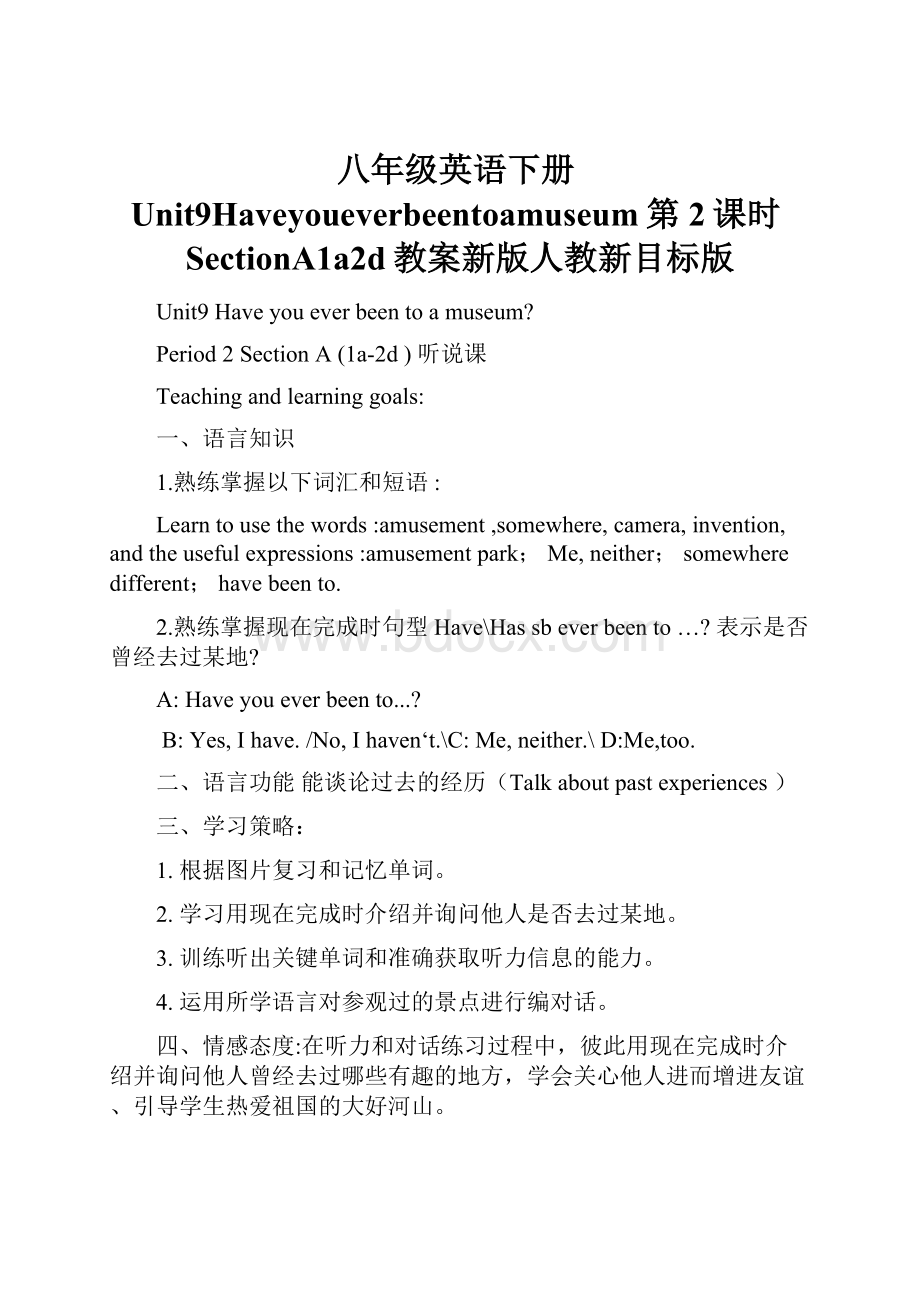八年级英语下册Unit9Haveyoueverbeentoamuseum第2课时SectionA1a2d教案新版人教新目标版.docx
《八年级英语下册Unit9Haveyoueverbeentoamuseum第2课时SectionA1a2d教案新版人教新目标版.docx》由会员分享,可在线阅读,更多相关《八年级英语下册Unit9Haveyoueverbeentoamuseum第2课时SectionA1a2d教案新版人教新目标版.docx(18页珍藏版)》请在冰豆网上搜索。

八年级英语下册Unit9Haveyoueverbeentoamuseum第2课时SectionA1a2d教案新版人教新目标版
Unit9Haveyoueverbeentoamuseum?
Period2SectionA(1a-2d)听说课
Teachingandlearninggoals:
一、语言知识
1.熟练掌握以下词汇和短语:
Learntousethewords:
amusement,somewhere,camera,invention,andtheusefulexpressions:
amusementpark;Me,neither;somewheredifferent;havebeento.
2.熟练掌握现在完成时句型Have\Hassbeverbeento…?
表示是否曾经去过某地?
A:
Haveyoueverbeento...?
B:
Yes,Ihave./No,Ihaven‘t.\C:
Me,neither.\D:
Me,too.
二、语言功能能谈论过去的经历(Talkaboutpastexperiences)
三、学习策略:
1.根据图片复习和记忆单词。
2.学习用现在完成时介绍并询问他人是否去过某地。
3.训练听出关键单词和准确获取听力信息的能力。
4.运用所学语言对参观过的景点进行编对话。
四、情感态度:
在听力和对话练习过程中,彼此用现在完成时介绍并询问他人曾经去过哪些有趣的地方,学会关心他人进而增进友谊、引导学生热爱祖国的大好河山。
【设计意图】:
从语言知识、语言功能、学习策略和情感态度四个方面阐述了本节课的教学目标,层次清晰,一目了然。
Teachingandlearningsteps:
Step1.Pre-listeningactivities
1.Preview
I.AsktheSstosayEnglishwordsaccordingtoChineseandsayChineseaccordingtoEnglishonthescreen.ThenasktheSstotranslatethefollowingChineseintoEnglish.FirstasktheSstoputthemintoEnglishorally,thenletthemwriteEnglishdownwithoutlookingatthetextbooks.
(1)太空博物馆_________________
(2)国家科学博物馆_______________
(3)历史博物馆__________________(4)不同的地方________________
(5)曾经去过……_____________________(6)搭建帐篷____________
II.Askthestudentstotranslatethefollowingsentences.
(1)A:
你曾去过水上公园吗?
______________________________________________________
B:
不,我没去过。
_____________________________________
A:
我也没去过。
________________________________________
(2)A:
我曾去过艺术博物馆很多次。
_________________________________________________
B:
我也是。
____________________________________________________
(3)我从来没去科学博物馆。
_________________________________________
【设计意图】:
本部分先复习单词,让学生能熟练英汉互译单词并能准确熟练的说出来。
词组和句子为学生的预习作业,词组和句子都是本节课的重要语言知识,该部分预习内容可以帮助学生更有目的性的预习。
同时通过检测学生的预习效果,教师可以更有针对性地教,学生可以更有针对性的学,特别是数字的读法在此如果学生不会读可以单独教读。
2.Warmingupandleadingin.
T:
Boysandgirls,lookatthesepictures,doyouliketraveling?
Ss:
Yes.
T:
Great!
Mostofyouliketravelingverymuch.Metoo.IwenttoBeijing
lastyear.ButnowIaminXuecheng.That’stosay
IhaveeverbeentoBeijing.
T:
Therearesomanyfunplacesthere.LetmeshowyoutheplacesIhaveeverbeento.
Ihaveeverbeentotheamusementpark\thespacemuseum\
thehistorymuseum
\theartmuseum
\thewaterpark
andthezoo.
【设计意图】:
图片导入新课,让学生欣赏首都北京美丽景观的同时,并在此基础上熟读这些名字。
3.Presentation
1)T:
HaveyoueverbeentotheBeijingZoo?
S1:
Yes,Ihave.Whataboutyou,S2?
S2:
Me,too.
S2:
Haveyoueverbeentothesciencemuseum?
S3:
No,Ihaven’t.Howaboutyou?
T:
Meneither.Boysandgirls,pleaseworkinpairsandmakeyourownconversations.
A:
Haveyoubeento…?
B:
Yes,Ihave.\No,Ihaven’t.Whataboutyou?
A:
Me,too.\Meneither.
S:
...
T:
Great!
Allofyoudidagoodjob!
Youhavebeentosomanyinterestingplaces,whichoftheseplaceswouldyouliketovisit?
2).T:
Let’sturntoPage65.Lookat1aand.Pleaserankthem1to6.
【设计意图】:
首先用一般过去时向学生介绍自己曾经去过的地方,然后过度到现
在完成时,目的在于让学生感知现在完成时havebeento的用法,并且对一般过去时和现在完成时的区别有初步了解。
再做1a就比较容易,为做1b听力也做好了铺垫。
Step2.While-listeningactivities.
1.Listenforthegeneralidea听取大意
Themainideaoftheconversationistotalkabout .
A.amusementparksthatClaudiaandSarahhavebeento
B.someplacesofinterestthatClaudiaandSarahhavebeento
C.museumsthatClaudiaandSarahhavebeento
【设计意图】:
让学生通过听录音整体感知,并找出谈论的主旨大意。
2.Listenforthespecificideas听取细节
T:
Class,weknowClaudiaandSaraharetalkingabouttheplaceswheretheyhavebeento.Now,pleaselistentotherecordingcarefullyandcheck(√)theplacesthesestudentshavebeento.
First,letthestudentsgothroughthechartin1b.
Next,askthemtolistentotherecording(justonce)carefullyandchecktheplacesthesestudentshavebeento.
Then,checktheiranswersbyusingthestructures:
A:
HasClaudiaeverbeentoaspacemuseum?
B:
Yes,shehas.HowaboutSarah?
A:
No,shehasn’t.Shehasneverbeentothespacemuseum.
Finallylistenandcompletethesentences
1)Let’sdosomething______.
2)Haveyouever_________toasciencemuseum?
No,Ihaven’t.\Me,______.
3)I_________therelastyear.
【设计意图】:
第二次听,在听听力之前,引导学生快速浏览方框中的地点名词,并且给予
听力策略的指导:
即注重听两个人名,同时还要注意她们的声音;除此之外,还要注意一些关键句型,如:
Ihavebeento…/Yes,Ihave./Me,too./No,Ihaven’t./Meneither...在核对答案的时候,老师可以先给学生做个例子,引导学生用目标句型“Has\Have..beento…?
”来问,然后学生根据听力内容来回答,在核对答案的同时练习了目标语言,培养了学生的听说读写能力。
1.Listenforthegeneralidea(2a-2b)听取大意
T:
Boysandgirls,justnowwetalkedabouttheplaceswhereClaudiaandSarahhavebeento.Next,I’llshowyouanotherpicture.Whatplacescanyouseeineachpicture?
S1:
InpictureA,Icanseeawaterpark.InpictureB,Icanseeaconcerthall,ariverparkandasubway.
S2:
InpictureC,Icanseeahistorymuseum,aspacemuseumandasciencemuseum.
S3:
InpictureD,Icanseeasubway,anamusementparkandazoo.
T:
Good,therearesomanyplacesinthetown.Somekidsaretalkingsomethingaboutthem.Whataretheytalkingabout?
Pleaselistentotherecordingandgetthemainidea.
Listenandchoosethemainideaoftheconversations.
Themainideaoftheconversationsistotalkabout .
A.theplaceswheretheywanttogo
B.theplaceswherethey’dliketogoskating
C.theplaceswheretheyhavebeen,wheretheywanttogoandhowtheyaregoingtogetthere
【设计意图】:
让学生通过听录音整体感知,并找出谈论的主旨大意。
提高学生整体理解听力内容的能力。
2.Listenforthespecificideas听取细节
(1)Lookatthemapofthetown.Listenandcircletheplacesyouhear.
T:
Fromtheconversationweknowthekidsaretalkingabouttheplaceswheretheyhavebeen,wheretheywanttogoandhowtheyaregoingtogetthere.Next,pleaselistentotherecordingandcircletheplacesyouhear.
(2)Do2bListenagainandcircleT(fortrue)orF(forfalse).
(3)Listenagainandfillintheblanks.
【设计意图】:
在学生做听力之前,先让学生思考并总结出做该题的听力策略,这样可以帮助学生有针对性的去听,而且可以提高做题的准确率,消除学生对听力的恐惧心理,这样有利于学生快速而准确的找到答案。
此部分也为下一步的根据图表复述听力内容,以及语言输出环节做好铺垫。
Step3.Post-listeningactivities.
Task1.Listenandrepeat.
【设计意图】:
跟读部分是为了正音,让学生模仿录音的语音和语调,对培养学生的语速、语调是很有帮助的。
Task2.Retell.
【设计意图】:
学生根据表格中所提供的信息,对听力文本进行复述,训练学生的思维能力和语言表达能力。
2a,2b听力中涉及到一般现在时、现在完成时、一般过去时和一般将来时,在表格中分别用不同颜色标注,目的是为了提醒学生在复述的同时,注意时态的转换。
并为下面的makeasurvey做好铺垫。
)
Task3.Role-playtheconversation.
T:
Justnow,wetalkedabouttheplaceswheresomekidshavebeen,wheretheywanttogoandhowtheyaregoingtogetthere.Now,let’sreadtheconversationandanswerthefollowingquestions:
1.WhendidJillgotothefilmmuseum?
2.WhatdidJilllearnabout?
3.HasAnnaeverbeencamping?
`
First,getthestudentstoreadtheconversationandanswerthequestions.
Then,letthemputtheconversationintoChinese.
Next,roleplaytheconversationinpairsormaketheirownconversations.
Finally,asksomepairstogotothefrontoftheclassroomandperformittothewholeclass.
【设计意图】:
此部分是一个完整的口语示范对话,这是一个综合的、具有真实语境的口语活动,就是对前面所学语言的巩固和运用,同时也为后面理解和发现语言结构的特点和规律了更多的语言素材。
中下等生可以直接做课本上的对话,优等生可以谈论自己曾经去过的地方,学以致用。
Task4.Makeasurvey.(选做)
T:
Boysandgirls,fromthelisteningtextweknowClaudiaandSarahhavebeentomanyplaces,buttheyhaven’tbeentoXuecheng.
T:
Xuechengisalsoabeautifulcity,doyouthinkso?
Ss:
Yes!
T:
Let’sintroducesomefunplacestoyouandenjoythebeautyofourcity.
T:
Therearesomanybeautifulplacesinourcity,wherehaveyoubeen?
S1:
IhavebeentoXuecheng.
T:
Whendidyougo?
S1:
OnMayDay.
T:
Whatdidyoudo?
S1:
Iclimbedthehills,enjoyedthebeautifulfood,etc.
T:
Howcanpeoplegetthere?
S1:
Theycantakethetrain.
Targetlanguage:
Wherehaveyoubeen?
Whendidyougo?
Whatdidyoudo?
Howcanpeoplegetthere?
Youcanreportlikethis:
Inourgroup,Ihavebeento…Iwenttherewith…I…Ifyouwanttogothere,youcantake….…hasbeento…
【设计意图】:
通过设计一个真实、贴近学生生活的情景,激发学生的学习积极性,让学生运用所学内容,来完成一个生活中的真实的任务。
从而,达到了培养学生综合运用英语的能力,是知识转化为能力进而提高能力的重要环节。
通过上课情况来看,学生的参与度很高。
在对学生进行知识教育的同时,也注重对学生的情感教育。
教育学生要热爱家乡并好好学习,将来把我们的家乡建设的更漂亮。
Step4.Inquiryintoknowledgebytranslation.
1.
(1)Tinawenttothespacemuseumlastyear.
本句话谈论的是发生的事情,因此使用时。
(2)Johnhasneverbeentothespacemuseum.
本句话强调的是发生的事情对造成的影响或结果,因此使用时。
(3)Theyaregoingtotakethesubway.
本句话谈论的是发生的事情,因此使用时。
2.
(1)A:
IhavebeentotheartmuseumsmanytimesB:
Metoo.=SohaveI.
(2)A:
I’veneverbeenthere.
B:
Meneither.=NeitherhaveI.★英语中如果表示后者与前者情形,“”,常用引起的
倒装句,。
如:
A:
Myfriendsarehappy.
B:
(我也很高兴。
)
★英语中表示后者与前者情形,“”时,常用____引起的倒装句。
如:
A:
I’mnottall.
B:
(她个子也不高。
)
(1)A:
我喜欢语文。
B:
我也是。
A:
IlikeChinese.B:
(2)A:
我从没去过长城。
B:
我也没去过。
A:
Ihaven’tbeentoTheGreatWall.B:
【设计意图】:
鼓励学生通过合作学习自己总结,引导学生观察、发现、归纳和掌握语言规律,形成有效的学习策略,必要时老师可以给予适当的点拨,落实了以学定教。
通过“活学活用”、“全真考题”让学生进步一巩固neither,so的用法。
Step5.Summary.
【设计意图】:
学生总结本节课所学内容,对本课所学重要内容进一步深强化巩固。
同时培养学生的归纳总结能力,养成自主学习的习惯。
Step6.Theend-of-classtest当堂检测
一、用所给词的适当形式填空。
1.He____ever____(be)totheHistoryMuseumseveraltimes.
2.---_____youever____(be)tothezoo?
---Yes.I_____(go)therelastsummer.I____(see)manykindsofanimalsthere.
3.---WhereisMr.Wang?
---He______(go)tothelibrary.Hewantstoborrowsomelibrarybooks.
4.Tom___________(notbe)toDisneylandandhe________(go)therewithhisparentsthisweekend.
5.There___________(go)tobeafootballmatchnextweek.
二、根据2d对话,补全下列短文。
Annawenttothefilmmuseum_______________.Shethinksthefilmmuseumisreally____________.Shehas_______beencamping.
Jillwentthefilmmuseumin_____.Shelovesalltheoldmoviecameras,andshelearnedabouttheinventionsthatledto____________.Ontheweekend,Jill________inthemountainswithsomefriends
【设计意图】:
当堂检测题是针对本节课所学内容进行的形成性评价,这样既能使学生巩固本节课所学知识,又能让老师了解到学生本堂课真实的学习情况,并对错误较多的知识点进行巩固强化。
在学生做题时,给予一定的策略指导,